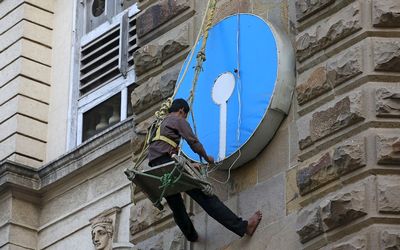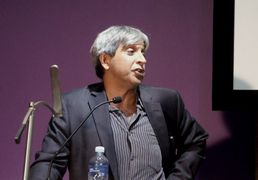Shining India must stay the course
by Martin Wolf,
2016-03-17 05:50:56.0
FORTY years ago, I worked on the Indian economy for the World Bank. Ever since, I have been fascinated by the place. The ability of this huge and poor nation to sustain a lively democracy has been among the world’s political wonders.
Yet, its economic performance has fallen short of what it might have been. Despite improvements in policy and performance since the crisis of 1991, this remains the case. Nevertheless, India is now the world’s fastest-growing large economy. What might it be in future?
It is with this question in my mind that I have visited Delhi in recent days. It is hard to judge what is happening in terms of immediate performance and policy. But four conclusions emerge.
First, Prime Minister Narendra Modi’s Hindu nationalist Bharatiya Janata (BPJ) party government, in power since 2014, represents continuity rather than the pro-market transformation many supporters naively expected.
Second, short-term performance and prospects appear favourable relative to the immediate past and to what is happening almost everywhere else.
Third, medium-term performance should also be decent, provided the government implements the reforms it has already outlined. This is partly because India retains so much potential.
Yet, fourth, it also faces risks, external and internal. Success must not be taken for granted.
An MP, from neither the BJP nor the Congress party, told me the government was "above average". When it is compared with those of the past quarter of a century, this seems right.
When the government came to power, the economy was suffering from consumer price inflation and fiscal deficits. Helped by falling oil prices, the former is down from above 10% in 2013 to below 6%.
The central government’s fiscal deficit is forecast to fall from 4.5% of gross domestic product (GDP) in 2013-14 (April to March) to 3.5% next year. The economy grew only 5.3% in 2012-13. This is forecast to reach 7.5% in 2015-16.
This would not be stellar by India’s standards. But it would be stellar by those of the world.
Performance, then, seems satisfactory. Will it remain so? Probably, particularly since the central bank should be able to cut interest rates below today’s 6.75% in the next few months. Furthermore, after two poor years, the coming monsoon rains may well be bigger. Yet, the near-term optimism must be qualified: first, exports, stagnant for years, are now falling; second, credit growth has slowed sharply; and, third, gross investment fell from 39% of GDP in 2011-12 to 34.2% in 2014-15. It is vital this is at least stabilised.
India could sustain growth at something close to current rates into the medium term. According to the International Monetary Fund, its GDP per head (at purchasing power parity) is just 11% of US levels, against China’s 25%. This indicates substantial room for fast catch-up growth.
Nevertheless, India must not be complacent. The country has shifted from socialism with restricted entry to capitalism without exit: closing down businesses and laying off workers is extremely difficult. The latter is one reason jobs in the organised private sector amount to 2% of the labour force. Markets for land, labour and capital are all highly distorted. High protection at the border restricts the ability to participate in global value chains. Important product markets are uncompetitive and the quality of education is poor. In all, a huge amount of change is still needed. Yet, pressure from a rising middle class is likely, in the end, to force much needed reforms.
This leaves three other risks. One is outright conflict, most plausibly with Pakistan. This looks unlikely. Another is a global slump. But a slump big enough to derail growth in a nation of India’s size and diversity seems unlikely.
A final risk derives from the BJP’s "Tea Party" — its chauvinistic, intolerant elements. One of the miracles of postindependence India is the way people divided by religion, caste and opinion live democratically and mostly peacefully, side by side.
If it is to last, responsible politicians must remember that they govern for all Indians, including those they dislike or disagree with. Tolerance of differences matters in all democracies. In one as huge and complex as India, it is truly vital.
Financial Times

BALANCING ACT: An electrician puts lights on the logo of State Bank of India at its main branch in Mumbai, India. Although the country is now the world’s fastest-growing large economy, a huge amount of change is still needed. File picture: REUTERS/DANISH SIDDIQUI
FORTY years ago, I worked on the Indian economy for the World Bank. Ever since, I have been fascinated by the place. The ability of this huge and poor nation to sustain a lively democracy has been among the world’s political wonders.
Yet, its economic performance has fallen short of what it might have been. Despite improvements in policy and performance since the crisis of 1991, this remains the case. Nevertheless, India is now the world’s fastest-growing large economy. What might it be in future?
It is with this question in my mind that I have visited Delhi in recent days. It is hard to judge what is happening in terms of immediate performance and policy. But four conclusions emerge.
First, Prime Minister Narendra Modi’s Hindu nationalist Bharatiya Janata (BPJ) party government, in power since 2014, represents continuity rather than the pro-market transformation many supporters naively expected.
Second, short-term performance and prospects appear favourable relative to the immediate past and to what is happening almost everywhere else.
Third, medium-term performance should also be decent, provided the government implements the reforms it has already outlined. This is partly because India retains so much potential.
Yet, fourth, it also faces risks, external and internal. Success must not be taken for granted.
An MP, from neither the BJP nor the Congress party, told me the government was "above average". When it is compared with those of the past quarter of a century, this seems right.
When the government came to power, the economy was suffering from consumer price inflation and fiscal deficits. Helped by falling oil prices, the former is down from above 10% in 2013 to below 6%.
The central government’s fiscal deficit is forecast to fall from 4.5% of gross domestic product (GDP) in 2013-14 (April to March) to 3.5% next year. The economy grew only 5.3% in 2012-13. This is forecast to reach 7.5% in 2015-16.
This would not be stellar by India’s standards. But it would be stellar by those of the world.
Performance, then, seems satisfactory. Will it remain so? Probably, particularly since the central bank should be able to cut interest rates below today’s 6.75% in the next few months. Furthermore, after two poor years, the coming monsoon rains may well be bigger. Yet, the near-term optimism must be qualified: first, exports, stagnant for years, are now falling; second, credit growth has slowed sharply; and, third, gross investment fell from 39% of GDP in 2011-12 to 34.2% in 2014-15. It is vital this is at least stabilised.
India could sustain growth at something close to current rates into the medium term. According to the International Monetary Fund, its GDP per head (at purchasing power parity) is just 11% of US levels, against China’s 25%. This indicates substantial room for fast catch-up growth.
Nevertheless, India must not be complacent. The country has shifted from socialism with restricted entry to capitalism without exit: closing down businesses and laying off workers is extremely difficult. The latter is one reason jobs in the organised private sector amount to 2% of the labour force. Markets for land, labour and capital are all highly distorted. High protection at the border restricts the ability to participate in global value chains. Important product markets are uncompetitive and the quality of education is poor. In all, a huge amount of change is still needed. Yet, pressure from a rising middle class is likely, in the end, to force much needed reforms.
This leaves three other risks. One is outright conflict, most plausibly with Pakistan. This looks unlikely. Another is a global slump. But a slump big enough to derail growth in a nation of India’s size and diversity seems unlikely.
A final risk derives from the BJP’s "Tea Party" — its chauvinistic, intolerant elements. One of the miracles of postindependence India is the way people divided by religion, caste and opinion live democratically and mostly peacefully, side by side.
If it is to last, responsible politicians must remember that they govern for all Indians, including those they dislike or disagree with. Tolerance of differences matters in all democracies. In one as huge and complex as India, it is truly vital.
Financial Times























Change: 1.19%
Change: 1.36%
Change: 2.19%
Change: 1.49%
Change: -0.77%
Data supplied by Profile Data
Change: -0.08%
Change: 0.12%
Change: 1.19%
Change: 0.00%
Change: 0.10%
Data supplied by Profile Data
Change: 0.36%
Change: 0.38%
Change: 0.52%
Change: 0.44%
Change: 0.46%
Data supplied by Profile Data
Change: 0.22%
Change: -0.31%
Change: 0.06%
Change: -0.33%
Change: 0.17%
Data supplied by Profile Data